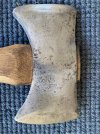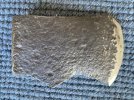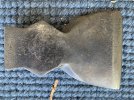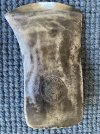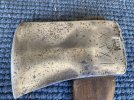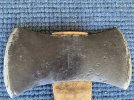PhilipWimberly
Gold Member
- Joined
- Oct 31, 2023
- Messages
- 46
I had never worked on metal in any way before about 9 months ago. I live in a silly gated "Barbie" neighborhood with gas logs in the house. I won't bother with how this all started, but now I own 34 axes and hatchets. The oldest seems to be pre-1900 and the youngest is probably 1960's.
I've been trying to learn to restore them, but only have sources like this forum and YouTube -- and no background at all with this kind of work. Half the time I think I've learned something, I find out later I misunderstood. I believe I may have crossed over to a point where my "restoration" actually improves more heads than I hurt, but it's still a close ratio, I'm afraid.
All that to make sure you know who you're talking to when you read this question:
What is the black stuff?
In some cases, it is a (thicker) uniformed layer all over the head. It comes off as dust with heavy pressure.
In some cases, it is spots -- in pits I haven't sanded off, but also often spots on what feels like smooth iron.
In some cases, it is a light film, fading and darkening across the faces of pristinely smooth heads.
In many cases, I can get it "gone" with sandpaper etc, but only in the right light. Change the light and I can see it again. Seems to be equally true whether I've sanded with 40 or in 8 stages from 40-320. In other cases, I think I've cleaned it off in the afternoon, but the next morning, it's back. (I live on the coast of NC. Not directly on saltwater, but close and only my very earliest work on these heads has happened in the heat and humidity of our Summer. The axes are stored in a closed garage at night.)
Please don't feel like I expect anyone to type an education for someone like me, but if anyone has links that might help me understand, I'd really appreciate it.
I've been trying to learn to restore them, but only have sources like this forum and YouTube -- and no background at all with this kind of work. Half the time I think I've learned something, I find out later I misunderstood. I believe I may have crossed over to a point where my "restoration" actually improves more heads than I hurt, but it's still a close ratio, I'm afraid.
All that to make sure you know who you're talking to when you read this question:
What is the black stuff?
In some cases, it is a (thicker) uniformed layer all over the head. It comes off as dust with heavy pressure.
In some cases, it is spots -- in pits I haven't sanded off, but also often spots on what feels like smooth iron.
In some cases, it is a light film, fading and darkening across the faces of pristinely smooth heads.
In many cases, I can get it "gone" with sandpaper etc, but only in the right light. Change the light and I can see it again. Seems to be equally true whether I've sanded with 40 or in 8 stages from 40-320. In other cases, I think I've cleaned it off in the afternoon, but the next morning, it's back. (I live on the coast of NC. Not directly on saltwater, but close and only my very earliest work on these heads has happened in the heat and humidity of our Summer. The axes are stored in a closed garage at night.)
Please don't feel like I expect anyone to type an education for someone like me, but if anyone has links that might help me understand, I'd really appreciate it.


